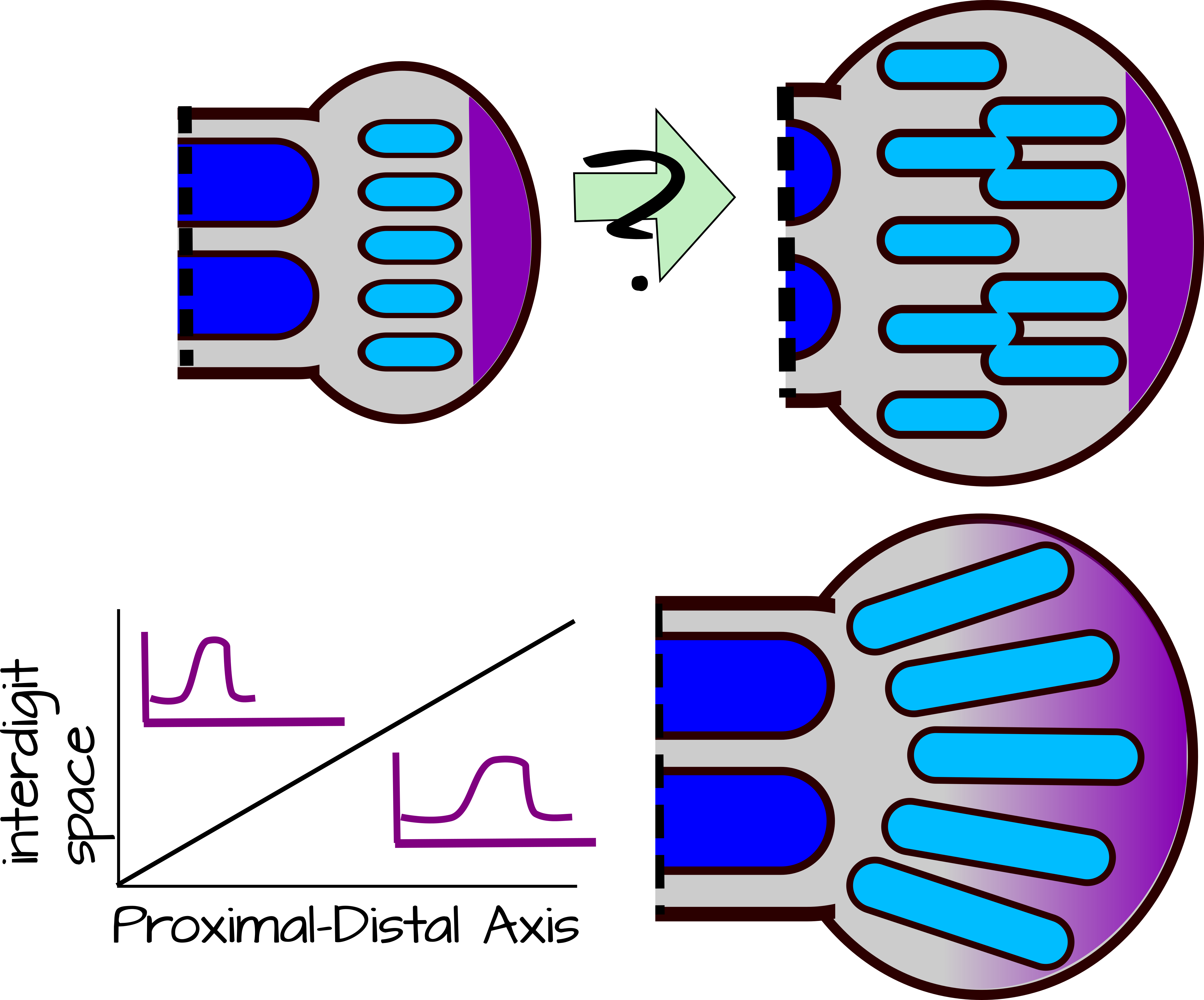7.2: A Turing-like Model for Generating Stripes in Digit Development (Rivera and Ramirez)
- Page ID
- 14886
Your limbs first begin growing as a small nubbin off your torso. As cells proliferate, a small rod of skeletal tissue begins to grow right in the middle. This will become the humerus or femur. This skeletal tissue is specified early on by Sox9, a transcription factor also involved in sex-determination. As the limb tissue grows longer and wider, two parallel bones appear (the radius and ulna or the tibia and fibula). The tissue grows longer and wider still, and five parallel bones appear - the metacarpals and eventually phalanges (Figure 3).
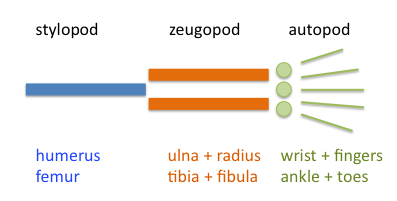 |
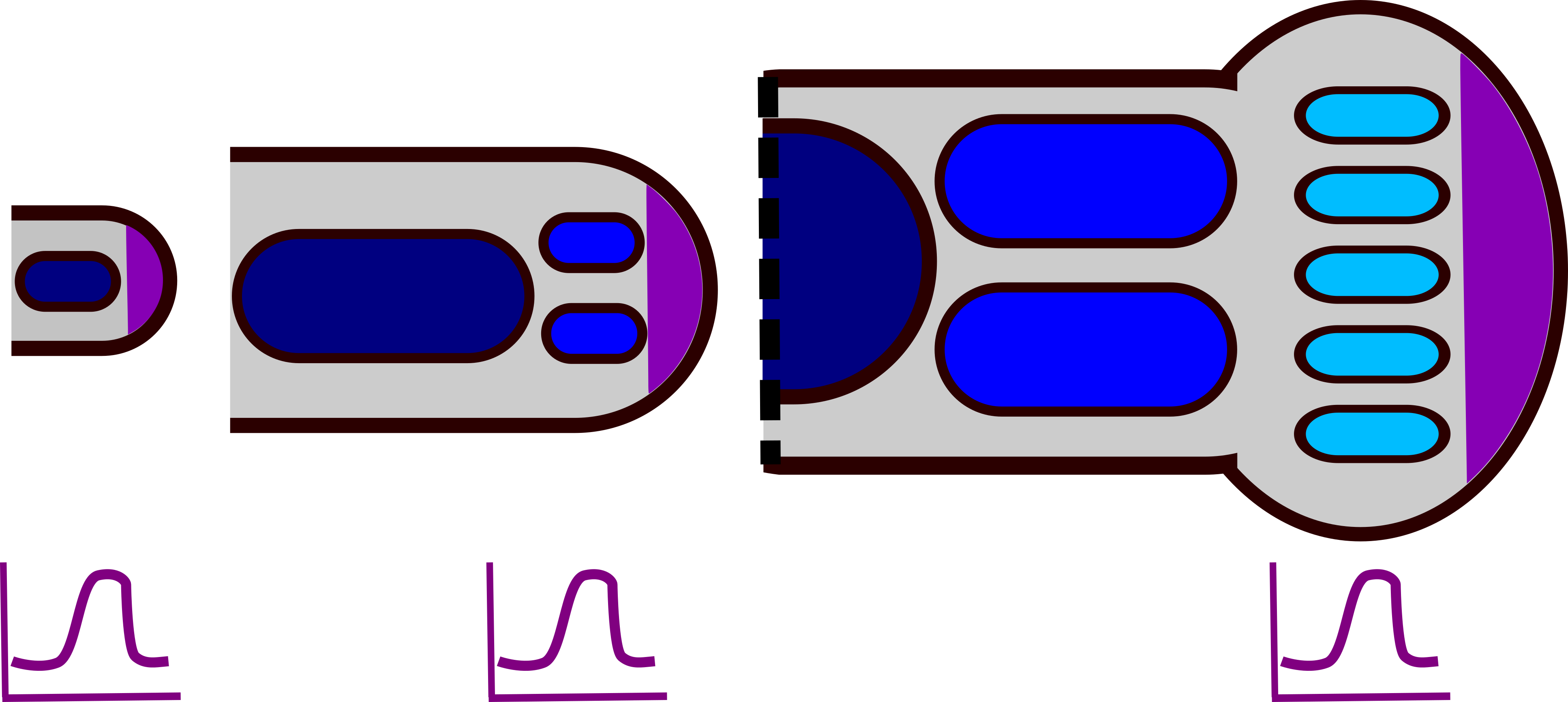 |
Figure 3: Parts of the Tetrapod Limb. Left panel is an image from wikimedia commons (Peteruetz) published under a CC BY-SA 3.0 license. Right panel shows a basic model of tetrapod limb development. As each cartilage condensation (blue, Sox9) forms, it becomes repressive to the formation of nearby condensations. The diffusion and strength of repression give a "wavelength" shown in purple, outside the wave, condensations can form (X-axis is proximal-distal axis and Y-axis is strength of repression). The yellow region is a region of instability (high concentration of FGFs from the Apical Ectodermal Ridge) where condensations cannot form. As the limb grows larger, there is room for more condensations with the same wavelength. An editable svg file of the right panel can be downloaded at https://scholarlycommons.pacific.edu/open-images/32/
An early model for limb development proposed that an inhibitory diffusable morphogen is made by the cartilage condensations (that will later become limb bones). In the early limb bud, this inhibitor can diffuse across the entire tiny tissue, so only one condensation is laid down forming the large bone of the stylopod. As the limb grows longer and wider, the inhibitor cannot reach high enough concentrations to cover the entire width of the limb bud and two condensations form (the parallel bones of the zeugopod) form. In the developing autopod, the tissue is wide enough to support 5 mutually-inhibitory condensations - the five digits of the foot or hand (Figure 3)16. Several Turing models can generate a stripe pattern like this including the Activator Inhibitor model and the Substrate Depletion model (Figure 4).
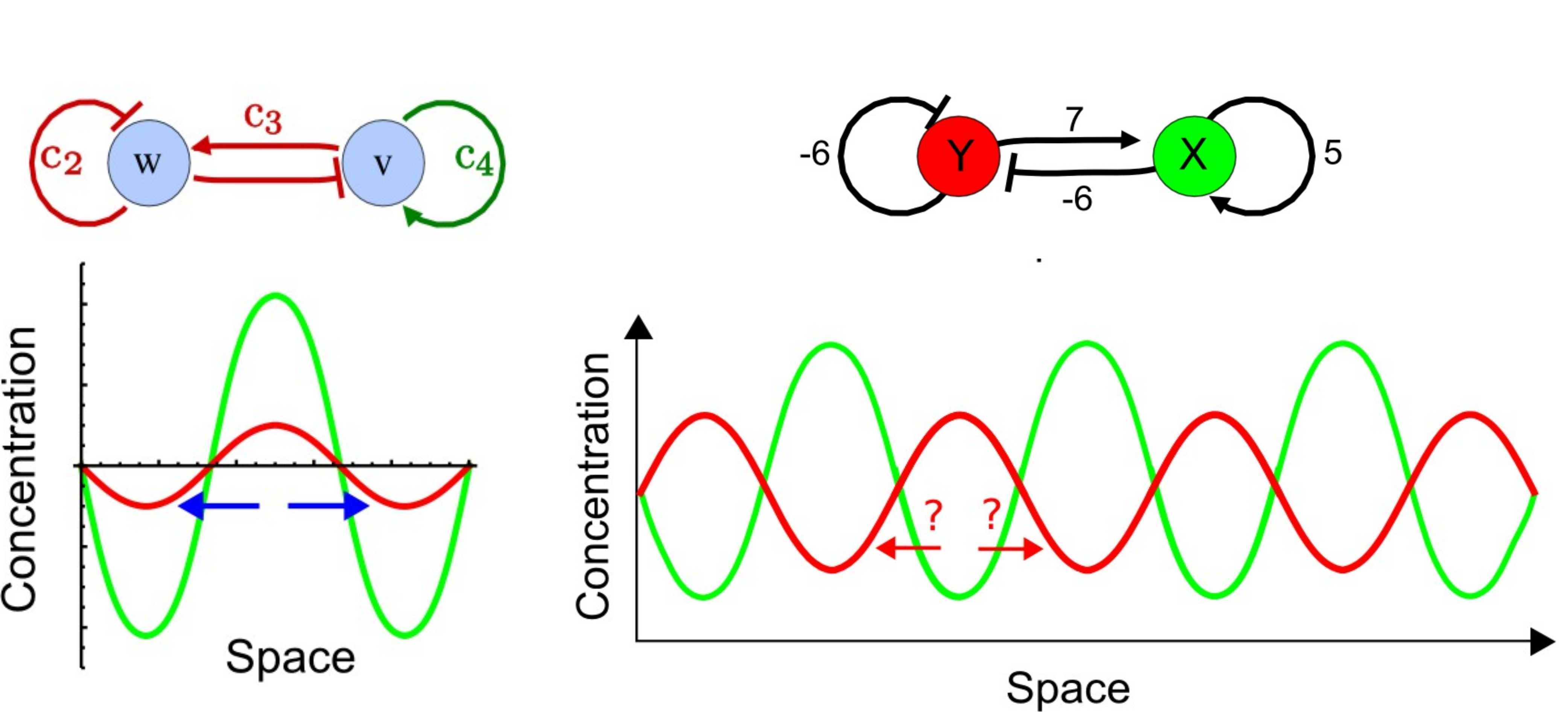 |
Figure 4: Two Turing models for digit stripes. The model on the left is an Activator Inhibitor Model where diffusible activator V activates itself as well as diffusible inhibitor W. Inhibitor W inhibits itself and activator V. The cs represent different interaction strengths. The model on the right is a Substrate Depletion model, where diffusible activator X uses up (or inhibits) substrate Y. Thus substrate Y inhibits itself by activating it's own inhibitor. To test between these models, the expression of molecules thought to be involved in the process can be assayed. If the expression patterns are overlapping (graph on the left) then the Activator Inhibitor model is supported. If the expression patterns are complementary (graph on the right) then the Substrate Depletion model is supported. Figure modified from original figures by Marcon et al, 201621 originally published under a CC BY 4.0 license |
Experiments on proteins expressed in either the interdigit areas or digits provided support for the Substrate Depletion Model17. However, these experiments also showed that instead of single proteins, digit patterning is actually specified via several interacting signaling pathways. Bmp, Sox9, and Wnt form the core components of the patterning that generates the "wavelength" of digit distance. All three of these genes form expression gradients, with the highest Sox9 in the middle of the digits and the highest Bmp and Wnt in the interdigits (Figure 5)17. Bmp expressed in the interdigit areas represses itself but diffuses outward to activate Sox9 in the nearby cells (the future digits). Sox9 represses Bmp, ensuring Bmp is only expressed in the interdigits. Wnt ligands are ubiquitous, but its targets (including b-catenin) are only expressed in the interdigits. Loss of b-catenin results in an expansion of Sox9 expression and an expansion of b-catenin expression reduces Sox9 expression, suggesting that Wnt/b-catenin is a repressor of Sox919,20. These interactions give a model where the digits form in a regular pattern with a wavelength specified by the strength of the Bmp/Sox9/Wnt interactions and the ability of Bmp and Wnt to diffuse (Figure 5)17.
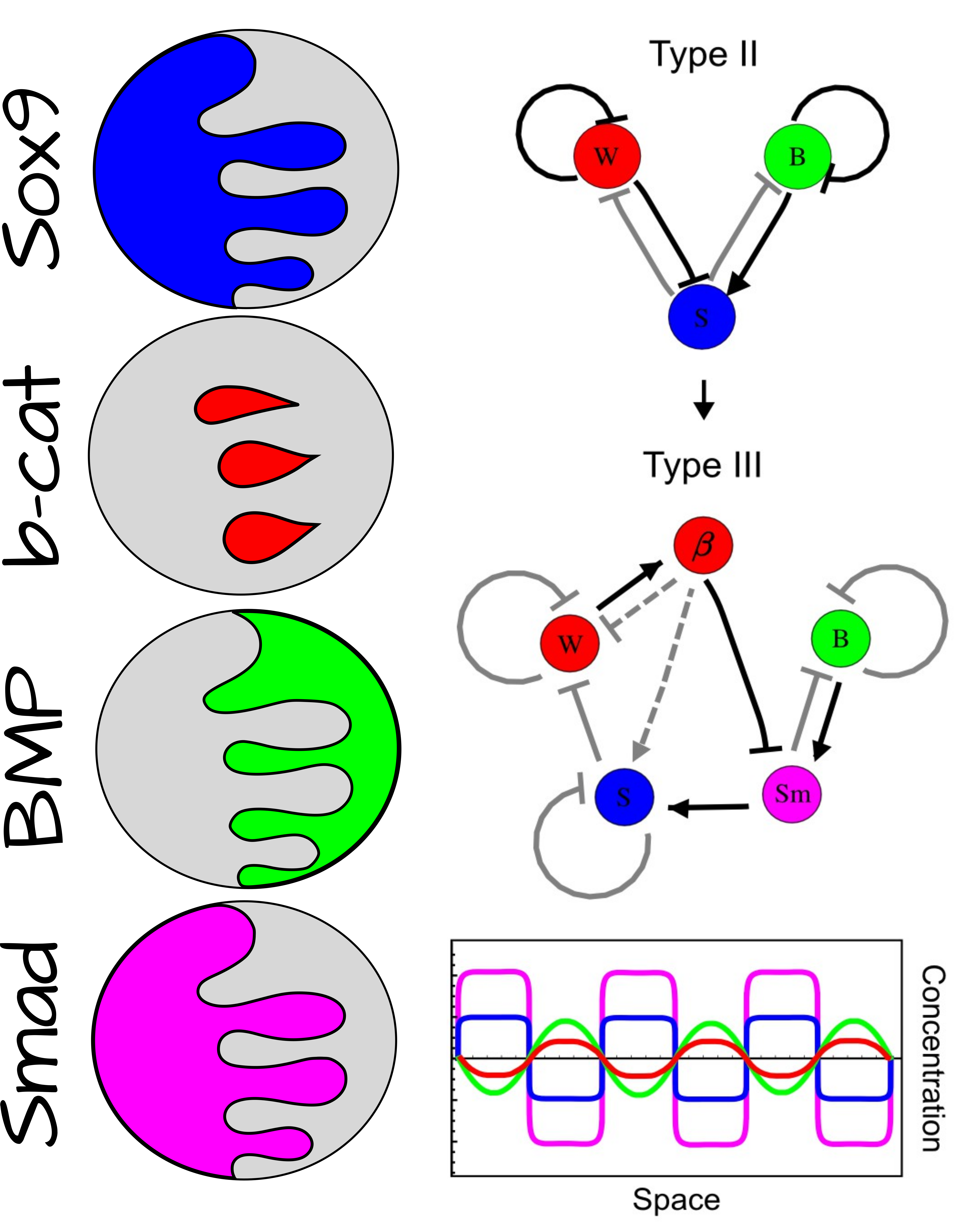 |
|
|
Figure 5: The Raspopovic et al.17 model for digit specification. Sox9, the primary digit marker, specifies cells to form skeletal condensations. It is expressed in the cells that will become digits in the autopod. In this model, Sox9 (blue) is the activator and it interacts with the BMP and Wnt signaling pathways. Autopods are shown as grey circles in the left column with color-coded expression patterns. Sox9 and Smad (purple, output of the BMP pathway) are expressed in the digits while BMP (green) and b-catenin (red, output of the Wnt pathway) are expressed in the interdigits. The left column shows the Turing model for these interactions. The top model was originally proposed by Raspopovic et al17 and subsequently refined by Marcon et al21. The Marcon et al model maintains the centrality of Sox9, which represses its own expression outside the condensation. Sox 9 inhibits the Wnt pathway, which represses b-catenin and other target genes in the Sox9 zones. b-catenin represses Smad, which is a target of diffusible BMP signaling. The inhibitory action of Smad on BMP ensures that BMP is not active in the Smad-expressing cells, giving these two members of the BMP pathway complementary activation patterns. The bottom right panel summarizes the output of the complex Marcon et al model. Modified from Marcon et al21 originally published under a CC BY 4.0 license An editable svg version of this figure can be dowloaded at: https://scholarlycommons.pacific.edu/open-images/33/ |
Figure 6: Modifying the wavelength. The paddle-shaped autopod should allow for additional condensation formation as it grows. This should lead to additional bones in the distal portion of the autopod or branching of existing condensations (top panel). Hoxd13 mutants give phenotypes like the top panel suggesting that Hoxd13 modifies the wavelength of the Sox9 condensations. Hoxd13 diffuses from the Apical Ecodermal Ridge and forms a gradient (yellow). Where Hoxd13 levels are high, the wavelength (or interdigit space) is large. Where Hoxd13 levels are low, the wavelength is small. The modulation of Hoxd13 levels and/or its ability to regulate the wavelength results in unbranched digits17,18. An editable svg version of this figure can be dowloaded at: https://scholarlycommons.pacific.edu/open-images/34/ |
But there's one big problem with this. Unlike the zeugopod and stylopod, the autopod is paddle-shaped. That means that it grows wide quickly during development, making a tissue that should support more cartilage condensations at the tip than near the wrist by the proposed model (Figure 6). This problem is solved by Hoxd13. Hoxd13 is a a Hox gene that helps pattern the hands, feet, unrinary tract, and reproductive organs. In the hands and feet (autopods) it is expressed in a gradient, with the highest levels near the Apical Ecodermal Ridge (AER) at the tip of the limb bud. Hoxd13 stabilizes the digit number in two ways. First, it acts as a "no patterning zone." In the region with highest Hoxd13, the expression of Sox9 is unstable and new condensations cannot form. Further away from the AER in an area of lower Hoxd13, new Sox9-driven condensations can form. Even further away from the AER, where there is no Hoxd13 expression, the existing condensations are stable. No new condensations will form even as the tissue grows wider. Hoxd13 also stabilizes digit number by increasing the ability of Sox9 to inhibit Bmp and Wnt. This has the effect of making the digit wavelength wider in the distal portion of the autopod, repressing the development of additional digits there (Figure 6)18. In Hoxd13 mouse mutants, the cartilage condensations of the autopod branch in the distal portions, following the natural wavelength of the Bmp/Sox9/Wnt interaction18.
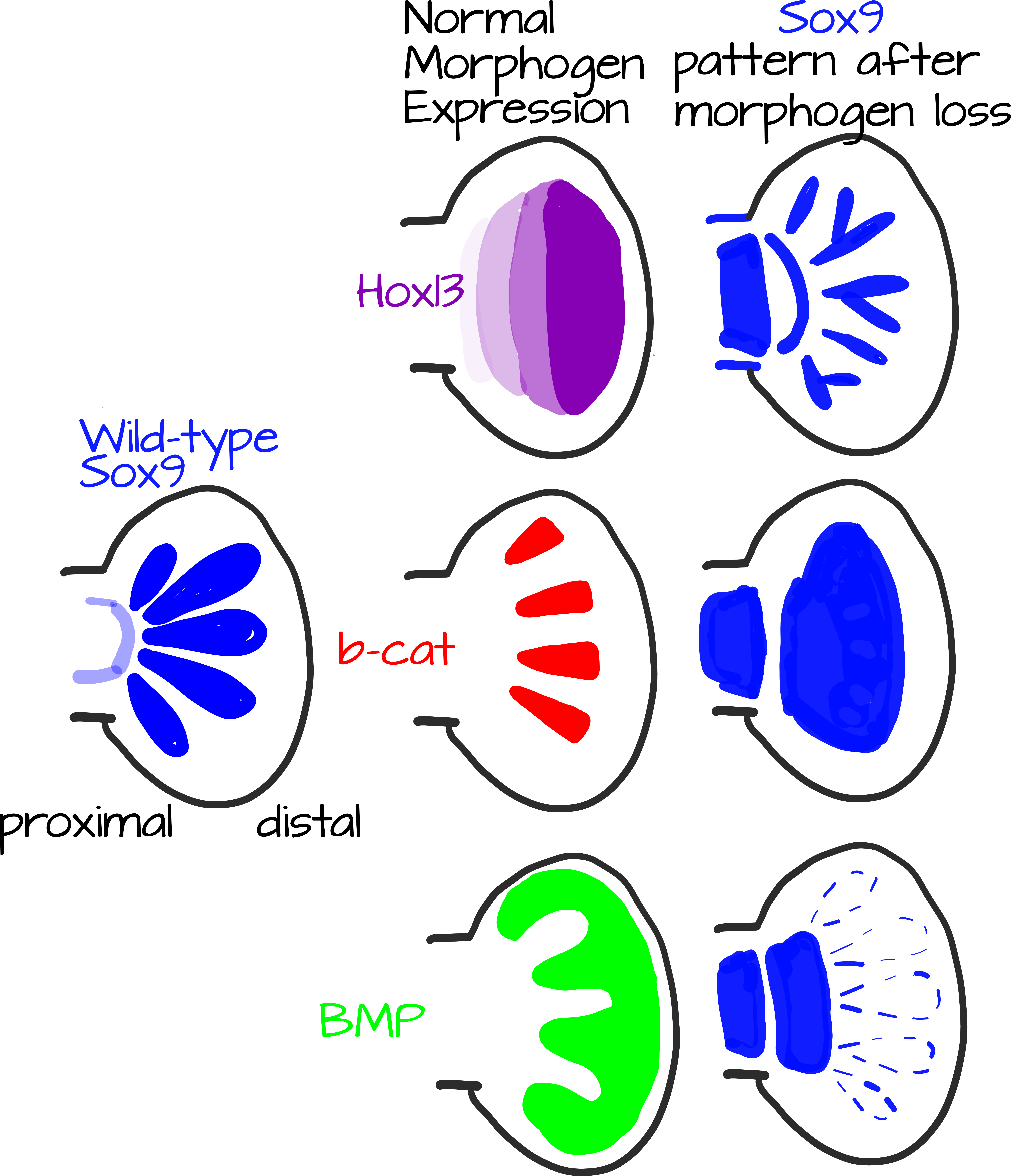 |
Figure 7: Mutations in regulators of Sox9 expression. Sox9 is normally expressed in vertebrate skeletal elements (future bone and cartilage). On the left is the typical Sox9 expression pattern in the autopod. The middle column shows normal expression of three morphogens involved in Sox9 patterning in the autopod. Hox13 (purple) comes from the AER and forms a gradient that is higher at the distal end and lower at the proximal end. b-cat (beta-catenin, red) is highest between the digits (in the interdigits). BMP (green) is highest everywhere except the skeletal elements, including in the interdigits. Loss of function mutations in each of these genes reveal their function in tuning the Turing mechanism for digit formation. Hox13 normally establishes a longer Sox9 wavelength in the distal end of an autopod. Hox13 mutants exhibit the proximal wavelegth at the distal end - resulting in branched digits. b-cat normally prevents Sox9 from being expressed in the interdigits. b-cat mutants exhibit skeletal elements across the autopod. BMP normally causes the secretion of Smads, which cause the expression of Sox9 in cells not expressing BMP. BMP mutants result in a loss of skeletal elements. Figure by Desmond Ramirez |
 |
Dr. Desmond Ramirez, PhD is a Postdoctoral Fellow working in the Katz Lab at UMass, Amherst. Learn more about his work at https://desmondramirez.wordpress.com/ |



